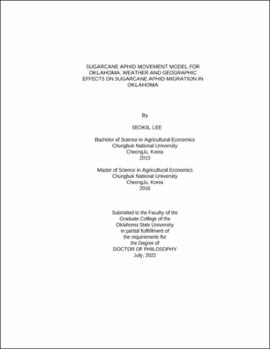| dc.contributor.advisor | Lambert, Dayton M. | |
| dc.contributor.author | Lee, Seokil | |
| dc.date.accessioned | 2023-04-05T16:21:02Z | |
| dc.date.available | 2023-04-05T16:21:02Z | |
| dc.date.issued | 2022-07 | |
| dc.identifier.uri | https://hdl.handle.net/11244/337295 | |
| dc.description.abstract | The first paper discusses developing a predictive model of SCA intrusion trajectories for Oklahoma sorghum producers. The SCA survival rates and migration distribution are generated using the temperature, precipitation, wind direction, and wind speed. A clustering algorithm was used to generate groups of low and high infestation probabilities, and the fields that could be infected. Each day's initial and movement probability depends entirely on the wind direction recorded on that day. However, as time passes, the importance of wind direction diminishes. The probability distributions have advantages in terms of data availability and cost, unlike multispectral and visual reporting. The SCA survival rates and migration distribution could provide a framework for future research regarding SCA survivability and migration modeling. | |
| dc.description.abstract | The second paper measures the effects of weather, geographic, and biological characteristics of SCA on the infestation of sorghum fields in Oklahoma. Infestation likelihood curves were used to measure the single effect of each covariate. Infestation likelihood curves suggest there is a difference in the infestation probability between the high- and low-density wing/un-winged SCA groups. The larger the ratio of winged to un-winged SCA, the more likely their movement to other sorghum fields. The PHM results reaffirmed that weather is an important factor in determining infestation hazard. Field location and the distance between sampled fields was not a significant factor. The total population of SCA per plant in the most recently infested field was negatively correlated with infestation hazard. The infestation curve and PHM results provide field-level information about more detailed infestation hazard. These aids may improve field-level decision-making for pest control planning, such as coordination of pesticide use and harvest timing. | |
| dc.format | application/pdf | |
| dc.language | en_US | |
| dc.rights | Copyright is held by the author who has granted the Oklahoma State University Library the non-exclusive right to share this material in its institutional repository. Contact Digital Library Services at lib-dls@okstate.edu or 405-744-9161 for the permission policy on the use, reproduction or distribution of this material. | |
| dc.title | Sugarcane aphid movement model for Oklahoma, weather and geographic effects on sugarcane aphid migration in Oklahoma | |
| dc.contributor.committeeMember | Lambert, Dayton M. | |
| dc.contributor.committeeMember | Vitale, Jefferey | |
| dc.contributor.committeeMember | Brorsen, B. Wade | |
| dc.contributor.committeeMember | Giles, Kristopher L. | |
| osu.filename | Lee_okstate_0664D_17815.pdf | |
| osu.accesstype | Open Access | |
| dc.type.genre | Dissertation | |
| dc.type.material | Text | |
| dc.subject.keywords | geographic | |
| dc.subject.keywords | migration | |
| dc.subject.keywords | probability function | |
| dc.subject.keywords | proportional hazard | |
| dc.subject.keywords | sugarcane aphid | |
| dc.subject.keywords | weather | |
| thesis.degree.discipline | Agricultural Economics | |
| thesis.degree.grantor | Oklahoma State University | |
